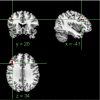Electroconvulsive therapy reduces frontal cortical connectivity in severe depressive disorder
- PMID: 22431642
- PMCID: PMC3325678
- DOI: 10.1073/pnas.1117206109
Electroconvulsive therapy reduces frontal cortical connectivity in severe depressive disorder
Abstract
To date, electroconvulsive therapy (ECT) is the most potent treatment in severe depression. Although ECT has been successfully applied in clinical practice for over 70 years, the underlying mechanisms of action remain unclear. We used functional MRI and a unique data-driven analysis approach to examine functional connectivity in the brain before and after ECT treatment. Our results show that ECT has lasting effects on the functional architecture of the brain. A comparison of pre- and posttreatment functional connectivity data in a group of nine patients revealed a significant cluster of voxels in and around the left dorsolateral prefrontal cortical region (Brodmann areas 44, 45, and 46), where the average global functional connectivity was considerably decreased after ECT treatment (P < 0.05, family-wise error-corrected). This decrease in functional connectivity was accompanied by a significant improvement (P < 0.001) in depressive symptoms; the patients' mean scores on the Montgomery Asberg Depression Rating Scale pre- and posttreatment were 36.4 (SD = 4.9) and 10.7 (SD = 9.6), respectively. The findings reported here add weight to the emerging "hyperconnectivity hypothesis" in depression and support the proposal that increased connectivity may constitute both a biomarker for mood disorder and a potential therapeutic target.
Conflict of interest statement
The authors declare no conflict of interest.
Figures



References
-
- Department of Mental Health and Substance Dependence . Investing in Mental Health. Geneva: World Health Organisation; 2003.
-
- UK ECT Review Group Efficacy and safety of electroconvulsive therapy in depressive disorders: A systematic review and meta-analysis. Lancet. 2003;361:799–808. - PubMed
-
- Baxter LR, Jr, et al. Reduction of prefrontal cortex glucose metabolism common to three types of depression. Arch Gen Psychiatry. 1989;46:243–250. - PubMed
-
- Bench CJ, et al. The anatomy of melancholia–focal abnormalities of cerebral blood flow in major depression. Psychol Med. 1992;22:607–615. - PubMed
Publication types
MeSH terms
Grants and funding
LinkOut - more resources
Full Text Sources
Other Literature Sources
Medical

